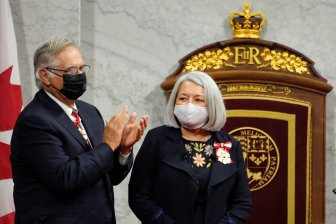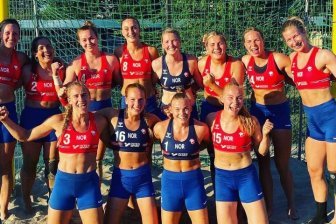When Aluki Kotierk heard the news that Inuk leader Mary Simon would be Canada’s next governor general — and the first Indigenous person to hold the role — she says she couldn’t hold back tears.
“The world changed,” said Kotierk, president of the Inuit organization Nunavut Tunngavik Incorporated.
Hearing Simon would be the Crown’s representative in Canada was groundbreaking, she said, and made her reflect both on the doors she watched Simon open years ago as a young Inuk leader as well as those Simon is opening up now for Indigenous youth, like Kotierk’s seven-year-old niece.
“I remember seeing her in the distance and realizing that I too could one day become an ambassador, and from that moment I knew the horizon of possibilities was expanded,” Kotierk told Global News.
“I think the recent announcement expanded it even further for young Inuit.”
Read more:
Mary Simon is now officially Canada’s first Indigenous governor general

Amid a national reckoning on the meaning of reconciliation and the dark legacies of residential schools, Simon’s installation as governor general is being billed as a chance to build bridges — to navigate, as Simon herself put it, the “tension of the past” and the “promise of the future.”
The ceremony itself was smaller than normal in a sign of the current, strange times: just 44 people were able to take part in person, a far cry from the hundreds of officials and political leaders normally crammed into the Senate chambers for the installation ceremonies of her predecessors.
But the size wasn’t the only way this ceremony differed from others.

All the way through the ceremony, Indigenous traditions and culture were present. Simon spoke in English and Inuktitut throughout, as well as offering remarks in cautious French. From the time she arrived on site, greeted by a First Nations drum circle, Simon was accompanied by a beating Inuit drum as she entered and left the chambers.
A traditional Inuit oil lamp remained lit during the ceremony.
“I was moved by the event and also not just that it’s a fellow Inuk that is now governor general, but the diversity of the program,” said Natan Obed, head of the national advocacy group Inuit Tapiriit Kanatami.
“It just felt like a glimmer of optimism and hope in the face of what has been a really tough couple of years.”
Read more:
Who is Mary Simon, Canada’s first Indigenous governor general?
Obed, who served on the advisory panel that presented Trudeau with a shortlist of candidates for the position, said Simon’s emphasis on her experiences living in the Inuit world and the non-Indigenous world throughout her career gives her a unique perspective on how to bring Canadians together.
“She, I think, is understanding the ability that she has in the moment today and in the coming months and years to bring Canadians together and to move beyond the challenges that we all are facing,” he said, “and do it in a way that brings people into a conversation rather than in a way that breaks Canadians into sides: those who perpetrated violence versus those who received it.”
“We are now in a phase where we need to talk just more openly and constructively with one another about what Canada is and its history, but then also how we move forward going together into the future celebrating each other, celebrating this country,” he continued, calling her a “role model.”
“I heard all of those messages in what she said, and it is entirely consistent with the way Mary has talked about these issues during the course of her career.”

In her installation speech, Simon spoke frequently about the issues she will prioritize: key among them, reconciliation, but also the work needed to “destigmatize” mental health and to promote climate change solutions, particular those led by communities bearing the brunt.
While the effects of climate change and the mental health toll of the pandemic have been felt across the country, their impacts have been particularly acute in Arctic and remote communities.
Read more:
‘Our very right to be Inuit’ violated by global inaction on climate change, activist says
Melting permafrost and a shifting climate present stark challenges in northern communities, and the suicide crisis among Indigenous youth has prompted multiple communities to declare states of emergency.
At the same time, the discoveries of the remains of what are believed to be more than 1,000 Indigenous children in unmarked burial sites at former residential schools have brought greater attention to the intergenerational trauma caused by the horrific abuse at the schools — and the need to speak openly about mental health supports as the country reckons with the path forward.
Simon said she hopes to “build bridges.”
“I have heard from Canadians who describe a renewed sense of possibility for our country and hope that I can bring people together. I have heard from Canadians who have challenged me to bring a renewed purpose to the office of governor general to help Canadians deal with the issues we are facing,” she said.
“Reconciliation is a way of life and requires work every day. Reconciliation is getting to know one another.”
George Lafond, a member of the Muskeg Lake Cree Nation, is an advisor with the Institute for the Study of the Crown in Canada and said while her appointment serves as a “punctuation point on the political reconciliation,” there remains work ahead.
“We’re on, as they say, the arc of history does slowly bend towards justice. And this was part of that movement today.”
For Kotierk, she said watching the ceremony left her with a feeling: “hopefulness.”
“I think the door for possibilities has widened today,” she said.

© 2021 Global News, a division of Corus Entertainment Inc.
















































